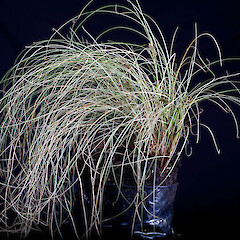Carex fretalis
Common name
curly sedge
Synonyms
None
Family
Cyperaceae
Flora category
Vascular – Native
Endemic taxon
Yes
Endemic genus
No
Endemic family
No
Structural class
Sedges
NVS code
The National Vegetation Survey (NVS) Databank is a physical archive and electronic databank containing records of over 94,000 vegetation survey plots - including data from over 19,000 permanent plots. NVS maintains a standard set of species code abbreviations that correspond to standard scientific plant names from the Ngä Tipu o Aotearoa - New Zealand Plants database.
CARFRE
Chromosome number
2n = c.60-64
Current conservation status
The conservation status of all known New Zealand vascular plant taxa at the rank of species and below were reassessed in 2017 using the New Zealand Threat Classification System (NZTCS) – more information about this can be found on the NZTCS website. This report includes a statistical summary and brief notes on changes since 2012 and replaces all previous NZTCS lists for vascular plants.
Please note, threat classifications are often suggested by authors when publications fall between NZTCS assessment periods – an interim threat classification status has not been assessed by the NZTCS panel.
- Conservation status of New Zealand indigenous vascular plants, 2017 . 2018. Peter J. de Lange, Jeremy R. Rolfe, John W. Barkla, Shannel P. Courtney, Paul D. Champion, Leon R. Perrie, Sarah M. Beadel, Kerry A. Ford, Ilse Breitwieser, Ines Schönberger, Rowan Hindmarsh-Walls, Peter B. Heenan and Kate Ladley. Department of Conservation. Source: NZTCS and licensed by DOC for reuse under the Creative Commons Attribution 4.0 International licence.
2017 | At Risk – Declining | Qualifiers: DP, Sp
Previous conservation statuses
2012 | At Risk – Naturally Uncommon | Qualifiers: Sp
2009 | At Risk – Naturally Uncommon | Qualifiers: DP
2004 | Range Restricted
Distribution
Endemic. South Island, Southland (Foveaux Strait area, Bluff Hill, Centre Island) and Stewart Island/Rakiura.
Naturalised in Tasmania (where it is erroneously known as C. comans Bergg.).
Habitat
A coastal species of relatively, exposed, open, damp, peaty ground, often overlying beach gravels. At Bluff Hill it has invaded surrounding pasture and is locally common along the track sides leading to the summit. On Stewart Island it often grows along tracks sides within the coastal portions of their routes, and is said to spread aggressively following fires or in heavily grazed areas.
Wetland plant indicator status rating
Information derived from the revised national wetland plant list prepared to assist councils in delineating and monitoring wetlands (Clarkson et al., 2021 Manaaki Whenua – Landcare Research Contract Report LC3975 for Hawke’s Bay Regional Council). The national plant list categorises plants by the extent to which they are found in wetlands and not ‘drylands’. The indicator status ratings are OBL (obligate wetland), FACW (facultative wetland), FAC (facultative), FACU (facultative upland), and UPL (obligate upland). If you have suggestions for the Wetland Indicator Status Rating, please contact: [Enable JavaScript to view protected content]
FAC: Facultative
Commonly occurs as either a hydrophyte or non-hydrophyte (non-wetlands).
Detailed description
Stiffly erect, tufted light yellow-green sedge with distinctly much curled and twisted leaf apices. Culms 100–150 × 0.5 mm, terete, glabrous, often elongating at maturity and becomign somewhat pendant toward the apex; basal sheaths light brown. Leaves more or less equal, or somewhat > culms, 1 mm wide, plano-convex, margins scabrid towards the very strongly cirrhose apex. Spikes 4–7; single terminal male spike rather slender; remaining spikes female, 10–25 × 4–5 mm, more or less oblong, more or less distant, erect, the uppermost sessile or shortly pedunculate, the lowest on a slender, pendant peduncle up to 10 mm long. Glumes (excluding awn) usually slightly < or equal to utricles, ovate-acuminate, hyaline though closely dotted with red brown striae, the cream midrib thickened and prolonged to an awn as long as glume or longer. Utricles 3.5 × 1 mm, plano-convex, ovoid, turgid, buff brown to tawny-yellow or tan, usually with distinctly paler nerves; scarcely narrowed to a glabrous beak, crura conspicuous, sometimes scabrid on margins; stipe relatively thick, 0.5 mm long, pale brown. Stigmas 3. Nut 1.5 mm, dark grey, trigonous, oblong-obovoid.
Similar taxa
Very closely related to Carex comans Bergg., from which it differs by the usually pale yellow-green leaves with strongly curled (cirrhose) apices, and light brown, never purple-brown basal sheaths. The inflorescence tends to be shorter and more stiffly erect and the spikes fewer, broader and with larger, usually glabrous utricles, which have a scarcely narrowed, usually glabrous beak rather than the distinct, and very scabrid beak seen in C. comans.
Flowering
October–December
Fruiting
October–August
Life cycle
Nuts surrounded by inflated utricles are dispersed by granivory and wind (Thorsen et al., 2009).
Propagation technique
Easily grown from fresh seed and by the division of established plants. It is this species which is the original Carex comans cv. ‘Frosted Curls’ popular in cultivation, which was first discovered by Terry Hatch of Joy Plants, Pukekohe on Bluff Hill and mistakenly assigned to C. comans Bergg. However, over the last decade much of what is sold as cv. ‘Frosted Curls’ is now, ironically, the green form of C. comans s.s. Carex fretalis does well in cultivation in a moist, free draining sunn situation or in semi-shade. It is naturalised in Tasmania.
Threats
Carex fretalis is perhaps least common in the Southland part of its range but it is abundant over large parts of Stewart Island/Rakiura. However, it is declining because of habitat loss.
Etymology
carex: Latin name for a species of sedge, now applied to the whole group.
fretalis: Belonging to a strait
Attribution
Fact sheet prepared for NZPCN by P.J. de Lange (8 September 2006). Description adapted from Moore & Edgar (1970)
References and further reading
Moore LB, Edgar E. 1970. Flora of New Zealand, Volume II. Indigenous Tracheophyta: Monocotyledones except Gramineae. Government Printer, Wellington, NZ. 354 p.
Thorsen MJ, Dickinson KJM, Seddon PJ. 2009. Seed dispersal systems in the New Zealand flora. Perspectives in Plant Ecology, Evolution and Systematics 11: 285–309.








